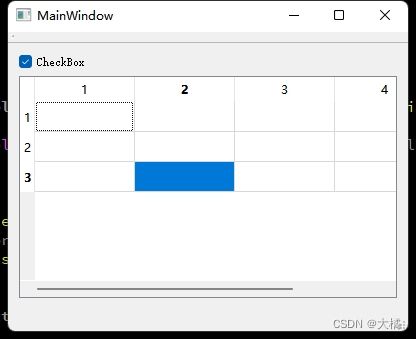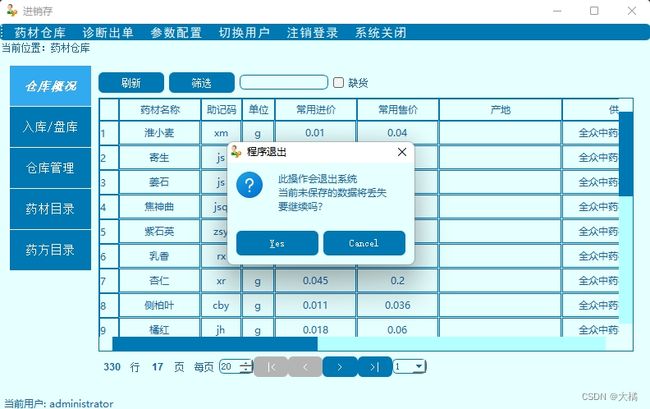【QT表格-6】QTableWidget的currentCellChanged实现中途撤销
背景:
【QT表格-1】QStandardItem的堆内存释放需要单独delete,还是随QStandardItemModel的remove或clear自动销毁?-CSDN博客
【QT表格-2】QTableWidget单元格结束编辑操作endEditting_qtablewidget 单元格编辑事件-CSDN博客
【QT表格-3】QTableWidget导入/导出excel通用代码,不需要安装office,不依赖任何多余环境,甚至不依赖编程语言_qt excel-CSDN博客
【QT表格-4】由QTableView/QTableWidget显示进度条和按钮,理解qt代理delegate用法_qtablewidget代理-CSDN博客
【QT表格-5】QTableView用代码设置选中状态-CSDN博客
一个主子表结构,当切换主表行时, 子表对应更新显示数据。主子表都可以编辑并保存。
当子表编辑后未保存时,如果切换主表行,应提示保存,用户可以选择“是”、“否”、“取消”。其实“是”和“否”好实现,因为都是保持顺序执行,只不过选择是否执行保存而已。但“取消”就不一样了,需要停止下面的操作。
这种情况比较多见,比如某个文本编辑器,如果编辑的内容,关闭时就应该有这样的询问。并根据用户选择进行相应操作。
按说用过vs的winform的同行应该知道,这个并不难。现在看来是因为vs提供了相当丰富的消息事件响应机制。比如关闭窗口会有一个类似CloseQuery这样的消息,只要对应写它的事件就好了。但是qt当中,思路会有很大区别。
问题:
实际上我尝试了很多方法已经就差cancel动作了。在QTableWidget::currentCellChanged槽当中判断,如果用户放弃的操作,我会重新把焦点放到previous位置,
this->setCurrentCell(previousRow, previousColumn);
这样看起来就是“回滚”了用户操作。但实际上效果是,焦点确实回去了,所有属性也回去了,比方说,currentRow或者currentItem之类,都没问题,但单元格的背景色没回去,也就是看起来还是选择了下一个位置。
这不傻了么?怎么试都不行,我猜想qt肯定是在currentCellChanged之后还干了什么事,而这个信号没有提供返回值和指针参数或者引用参数,等于没法控制。所以开始研究。
开胃菜:
以上述“窗口关闭前询问”为例,其实qt有个closeEvent函数,重写它就行了。它有个event指针参数,通过它是否accept就能控制是否继续。比如:
void MainWindow::closeEvent(QCloseEvent *event)
{
const QString sTitle = "程序退出";
const QString sMessage = "此操作会退出系统\n"
"当前未保存的数据将丢失\n"
"要继续吗?";
if (QMessageBox::question(this, sTitle, sMessage, QMessageBox::Yes|QMessageBox::Cancel,QMessageBox::Cancel)
== QMessageBox::Yes)
{
event->accept();
}
else
{
event->ignore();
}
}就像上图这样,挺简单的。
同理,很多需要控制是否继续的做法,都类似。
回到正题,最初我的需求怎么办?我需要切换主表行时来个询问,并决定是否继续。
分析:
如果直接套用closeEvent的思路,是想不通的。因为那是继承重写的做法。而表格是某个界面中的子对象,询问的操作需要在表格外实现,怎么重写?
像这种常见的界面互动,要么直接调用函数,要么信号槽。不想随便触动函数指针的概念,我感觉应该先深入了解qt的方式。
直接调用:业务是需要表格内部,根据外界的用户选择,来决定内部的流程是否继续。理论上是表格内部调用外部。但制作表格类的时候,是不知道外界是否需要询问,或者如何询问的。貌似无解。
信号槽:界面线程的互动属于directConnection,效果很顺序执行一样。这里涉及到信号槽的一些基础概念。主要是connect函数最后一个连接参数的应用。以手册为准。
【qt信号槽-5】信号槽相关注意事项记录-CSDN博客
但是信号槽怎么互动?发出去再传回来?难道需要收发两次?显然不是好办法,毕竟繁琐,主要是用起来感觉还不是随大流的风格。
过程:
过程艰辛,最终我是下载的qt源码才知道怎么回事的。这里只说关键步骤。
对于我的需求,主要用到QTableWidget::currentCellChanged信号,目的是能根据用户选择决定是否继续,还是取消。经过研究qt源码,QTableWidget.cpp有这样一段:
void QTableWidgetPrivate::_q_emitCurrentItemChanged(const QModelIndex ¤t,
const QModelIndex &previous)
{
Q_Q(QTableWidget);
QTableWidgetItem *currentItem = tableModel()->item(current);
QTableWidgetItem *previousItem = tableModel()->item(previous);
if (currentItem || previousItem)
emit q->currentItemChanged(currentItem, previousItem);
emit q->currentCellChanged(current.row(), current.column(), previous.row(), previous.column());
}这样看着后面没干什么事,只是看到currentItemChanged比currentCellChanged要靠前触发,而且有先决条件。接着看,_q_emitCurrentItemChanged这个信号是怎么来的。
void QTableWidgetPrivate::setup()
{
...
// selection signals
QObject::connect(q->selectionModel(), SIGNAL(currentChanged(QModelIndex,QModelIndex)),
q, SLOT(_q_emitCurrentItemChanged(QModelIndex,QModelIndex)));
QObject::connect(q->selectionModel(), SIGNAL(selectionChanged(QItemSelection,QItemSelection)),
q, SIGNAL(itemSelectionChanged()));
...
}那个q->selectionModel()跟踪一下就知道,它是QAbstractItemView::selectionModel(),是个QItemSelectionModel。主要看它的currentChanged和selectionChanged这俩信号的途径。
在qitemselectionmodel.cpp中搜索currentChanged就看见原因了,确实是currentChanged发送以后,会有更新界面的代码,最后再发送selectionChanged。代码太多就不贴了。
但是还有QTableWidget::setCurrentCell,QAbstractItemView::setCurrentIndex,最终都是执行的QItemSelectionModel::setCurrentIndex。而在这里面,selectionChanged是先于currentChanged的。
当执行setCurrent时,CellChanged是最后执行的。(这点要稍后考虑,先看用户主动操作的情况。后面在“疑点”部分逐一说明。)
当用户操作界面时,selectionChanged才是最后执行的,如果要回滚界面,也要在这里。但有个很恶心的事情。看这个:
QObject::connect(q->selectionModel(), SIGNAL(selectionChanged(QItemSelection,QItemSelection)), q, SIGNAL(itemSelectionChanged()));
连接时丢了两个很重要的参数,不知道qt为什么这样。(其实,qt也确实有类似的解决方案,我自己也不经意间用过,下文“疑点”会提到。)后来我想,也许提供一个没有参数的槽,更方便以后显式调用,因为不用刻意传参了,否则,如果在不容易获得入参值,而又想调用功能的情况下,就不方便了。
原因找到,解决就容易了。
方法:
我的QTableWidget自己包装了一个类,
先定义一个发往外界的查询信号:void sigRowChangeQuery(QEvent *event);。内含event指针,用于判断用户操作,很符合qt风格。这里注意,因为是界面交互,都在ui线程,所以默认是direct连接方式,所以可以接收到event的更改。
当然还有另外一个信号:void sigRowChanged(int iRow);,见名知意,通知外界行选发生。
写了槽on_currentCellChanged用于处理行选。其中:
if (m_bIsCurrentCellChangeProtected || currentRow < 0 || currentColumn < 0)
{
return;
}
if (currentRow != previousRow)
{
QEvent event(QEvent::None);
emit sigRowChangeQuery(&event);
if (!event.isAccepted())//If the slot was canceled by the user.
{
m_iRow_Rollback = previousRow;
m_iCol_Rollback = previousColumn;
m_bIsSelectionRollback = true;
return;
}
emit sigRowChanged(currentRow);
}
用两个变量记住要回滚的位置。再写槽on_itemSelectionChanged处理界面回滚:
int iRow = -1, iCol = -1;
if (m_bIsSelectionRollback)
{
m_bIsSelectionRollback = false;
iRow = m_iRow_Rollback;
iCol = m_iCol_Rollback;
}
else
{
iRow = this->currentRow();
iCol = this->currentColumn();
}
m_bIsCurrentCellChangeProtected = true;
this->blockSignals(true);
QTableWidget::setCurrentCell(iRow, iCol);
m_bIsCurrentCellChangeProtected = false;
this->blockSignals(false)
这样就行了。
外面处理用户操作时,写槽onGridMain_RowChangeQuery(QEvent *event),根据判断再设置event的accept标志,这样的用法就顺畅多了。是不是跟closeEvent用法一样?就是要这种效果。
所以这样的做法可以延伸的其它类似的场景。
疑点1:
上文提到:
当执行setCurrent时(比如setCurrentCell,setCurrentItem等),CellChanged是最后执行的。因为最终都是调用的QItemSelectionModel::setCurrentIndex:
void QItemSelectionModel::setCurrentIndex(const QModelIndex &index, QItemSelectionModel::SelectionFlags command)
{
Q_D(QItemSelectionModel);
if (!d->model) {
qWarning("QItemSelectionModel: Setting the current index when no model has been set will result in a no-op.");
return;
}
if (index == d->currentIndex) {
if (command != NoUpdate)
select(index, command); // select item
return;
}
QPersistentModelIndex previous = d->currentIndex;
d->currentIndex = index; // set current before emitting selection changed below
if (command != NoUpdate)
select(d->currentIndex, command); // select item
emit currentChanged(d->currentIndex, previous);
if (d->currentIndex.row() != previous.row() ||
d->currentIndex.parent() != previous.parent())
emit currentRowChanged(d->currentIndex, previous);
if (d->currentIndex.column() != previous.column() ||
d->currentIndex.parent() != previous.parent())
emit currentColumnChanged(d->currentIndex, previous);
}所以,使用代码设置当前位置时,情况跟用户点击是不一样的。qt会先设置selection,再触发cellchanged。
当然setCurrentCell和setCurrentItem函数,还提供了一个重载,带一个参数QItemSelectionModel::SelectionFlags,用于指定要不要更改selection。所以,在必要的地方setCurrentCell时,指定不更改selection,之后再显式调用一下on_itemSelectionChanged,相当于强制让selection设置在cellchanged之后。而调用无参的on_itemSelectionChanged确实更方便,这就又扣题上文了。
说明:on_itemSelectionChanged其实还是靠调用setCurrentCell来实现的selection状态变化。我没有用QTableView::setSelection函数。因为看过源码,内部的选择状态,是在一个叫selectionChanged的槽函数(“疑点2”中提到)内部实现的,而这个槽根本上还是靠QItemSelectionModel::selectionChanged这个信号触发的。而QTableView::setSelection是自己硬在界面层面计算rect实现的。这个就与内部联动脱节了,实在是不好操作,我还要考虑SelectionBehavior(选择模式:行,列,等)。所以不如让qt自带的功能实现更方便。
注意:因为on_itemSelectionChanged里面调用了setCurrentCell,如果不加标记还会触发currentCellchanged,那就死循环了,所以要考虑周全。
疑点2:
上文提到:
QObject::connect(q->selectionModel(), SIGNAL(selectionChanged(QItemSelection,QItemSelection)), q, SIGNAL(itemSelectionChanged()));
连接时丢了两个很重要的参数。且不提“疑点1”提到的方便调用问题,但其实qt有类似的解决方案。注意看,这个叫大壮的男人,点开了qt手册,他竟然发现了这么个玩意:
QTableWidget::selectionChanged(const QItemSelection &selected, const QItemSelection &deselected)
但其实以前也重写过这个虚函数,这次的问题,因为一开始没想到selection,所以没往这看。
跟踪一下就知道,这个虚函数继承自QAbstractItemView>QTableview。而它的触发,看源码:
void QAbstractItemView::setSelectionModel(QItemSelectionModel *selectionModel)
{
...
if (d->selectionModel) {
connect(d->selectionModel, SIGNAL(selectionChanged(QItemSelection,QItemSelection)),
this, SLOT(selectionChanged(QItemSelection,QItemSelection)));
connect(d->selectionModel, SIGNAL(currentChanged(QModelIndex,QModelIndex)),
this, SLOT(currentChanged(QModelIndex,QModelIndex)));
selectionChanged(d->selectionModel->selection(), oldSelection);
currentChanged(d->selectionModel->currentIndex(), oldCurrentIndex);
}
}还是从d->selectionModel的selectionChanged信号过来的,而d->selectionModel是QItemSelectionModel,所以,来源还是QItemSelectionModel::selectionChanged这个信号。这就和上文的方法对上了。
但是,利用selectionChanged这个虚函数,会否能做个更“优”解呢?我想目前是没有必要了。先这样,想到再补充。
心得:
个人感觉,qt源码中关于cellchanged和selection的顺序,应该保持一致就好了。
本文完。

